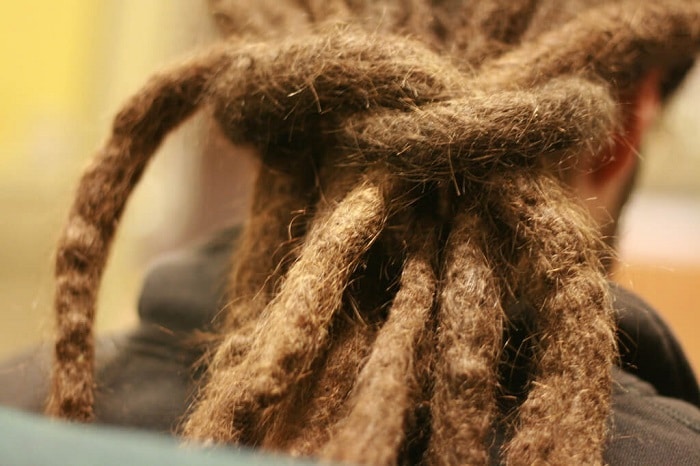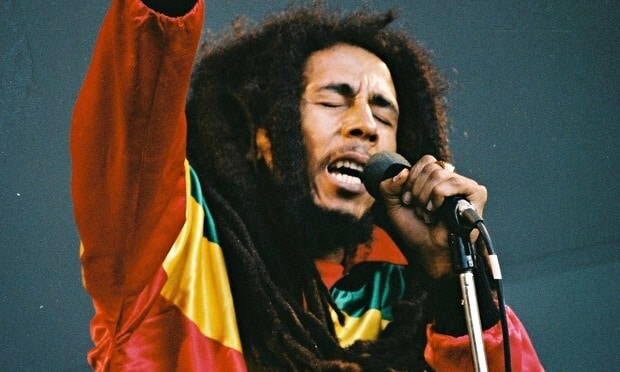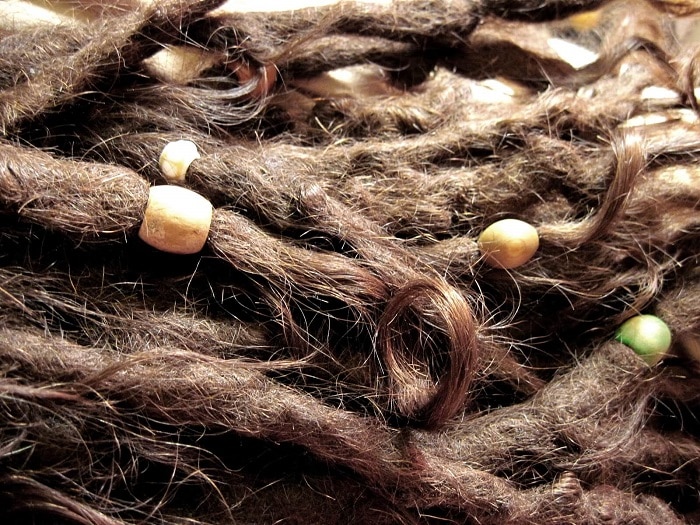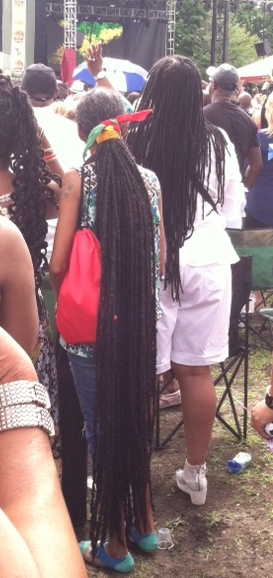The documented history of dreadlocks starts back about 3,600 years ago, in the Minoan civilization. Later, Julius Caesar said Germans had hair like snakes. Scientists assume prehistoric humanoids naturally developed dreadlocks.
Indian sages and Hindu Yogis cultures wore dreadlocks. Dreadlocks have different significance across many cultures, but they have one thing in common: they are a spiritual journey that teaches patience.
Check Out These Accessories

History of Dreadlocks in Ancient Times
Sculptures from the Archaic period of Ancient Greece depict dreadlocks men. Magistrates from Sparta followed this archaic Greek tradition, too, and braided their hair in long locks. Aztec priests kept their hair untouched, long, and matted. In Ancient Greece, Hindus and Israelite Cultures had dreadlocks. You can trace Dreadlocks back to 2500 BCE.
Shampoo and Wax for Dreadlocks
The professor from the University of Richmond, Dr. Bert Ashe has evidence of dreadlocks from India’s Vedic scriptures. Which he stated in his book “Twisted: My Dreadlock Chronicles”. His research further shows evidence of deity (God and Goddess) Shiva wearing hair of locks style. Dr. Ashe studies show words used in Vedic scriptures like “JaTaa”, meaning twisted locks of hair are further evidence of dreadlocks. He also found information where ancient Egypt Anthropologist has found mummies with locks.
During the African Trade Slave error, let’s say between 1600 – mid 1800s, slaves were not able to groom themselves because they were all shackled up. Because they didn’t have access to grooming, the owners of the enslaved people were known to call their hair dreadful. This resulting in the term dreadlocks and would unconsciously place a negative thinking with people wearing their hair into a lock’s hairstyle.
Brushes for Dreadlocks
Locks have become very popular over the years and are widely worn by all different races. The description on how locks are viewed is based on who is wearing it. If a locks are worn by a Rastafarian due to his religion, he’s referred to as a Rasta. The belief is that the locks prevent energy from escaping through the top of the head and keeping their strength. Whereas, when the locks are worn by others and not for religious purposes, the style is referred to as dread or dreadlock.
Significance of Dreadlocks in Ancient Cultures
In many cultures, some would say dreadlocks are a statement of disregard for physical appearance and earthly possessions. But for the group that practice the culture and the religion they would argue that their appearance represents and symbolize their focus and belief in their religion. The Rastafarian Religion teaching defines one’s spiritual growth and love for others.
The major focus does not gloat riches, instead to move away from vanity and physical European appearances. Their outward appearance should embrace their African Culture and religious belief. Rastafarians believe their dreadlocks are a sanctuary for physical, emotional, and spiritual strength. It’s part of the Rastafarian movement that centered around Ethiopia and the Emperor Haile Selassie I. Their locks symbolize the main of the Lion of Judah. The association with Ethiopia and Emperor Haile Selassie, a direct descendant of King Solomon and Queen Sheba through their son Menelik I, gave liberation to the Rastafarian movement.

In Egypt
The oldest documented examples of dreadlocks come Egypt, with Tutankhamun and other rulers. His mummy still wears the dreadlocks, more than 3,300 years later. There are also plenty of illustrations that prove signified a high social status. Many considered dreadlocks attractive in the Egyptian culture.
In Africa
Various African ethnic groups wear dreadlocks of different styles. Across cultures they mirror social status or certain talents. Warriors of the Maasai tribe, for example, wear long, thin, red locks of hair. In other cultures, shamans keep their long, in locks, yo distinguish themselves. Nigerian Childrens are called Dada, when they are born with natural locks. Priests from the Yoruba culture wear dreadlocks.
Buddhism
In medieval South Asia, many esoteric Buddhist rituals required the participants to have dreadlocks. Tibetan and other forms of Buddhism, however, substituted dreadlocks with shaving their heads over the years. They see hair as an excessive attachment, a material vanity even.

Aztecs
The Aztecs in Central America only considered high ranking priests worthy of this hairstyle. A man locks was shaved once he entered priesthood. The longer the locks of hair, the more experienced and powerful the priest.
Judaism & Christianity
At least 7 of the most important figures in the Abrahamic religions wore dreadlocks. The Hebrew Bible’s Book of Numbers has an oath that asks followers to display their devotion by not cutting their hair:
„No razor may be used on their head. They must be holy until the period of their dedication to the Lord is over; they must let their hair grow long.” – The Nazarite Vow
It also required to abstain from alcohol and grape products and not to come in contact with corpses or graves. This part of the bible had an impact on how the Rastafari movement developed in the 20th century. In fact, it might very well be the source of dreadlocks in the Rastafarian culture.
The History of Dreadlocks & their Significance in Jamaica
The Rastafarian culture quickly incorporated the piety of the abovementioned yogis and their knotty hairstyle. However, unlike eastern yogis for whom the locks were not a priority, Rastafarians highly valued theirs. The religious Rastafarians do not believe in putting any type of razor blade or scissors to their face and hair.

This hairstyle appeared after Jamaica’s emancipation in 1838. Rastafarianism appeared on November 2nd, 1930, in Jamaica – almost 100 years after the emancipation. Those who grew their hair in dreadlock did so to defy the Euro-centrism forced on ex-slaves. People were also calling the dreadlocks look dreadful, but the term later evolved to the current international term dreadlocks. Jamaicans, however, also call people with locks Natty Dreadlocks. These people grow their hair into locks but they are not necessarily part of the Rastafarian Religion. In Jamaica, Rastafarians do not like to be referred to as dread or dreadlocks. Some Rastafarians go as far as to say, “Dread do dreadful things, Mi a Rasta.”
The Significance of Dreadlocks in the Rastafarian Culture
For Rastafarians, growing their hair into dreadlocks is part of the Nazarite Vow. The locks hair was inspired by the Bible’s Nazarites – specifically, Samson, who realized that cutting his hair was a weakness, together with untrustworthy women. The Rastafarian belief is that the religion was inspired by the Bible. Ras is an Ethiopian title given to people with royal blood. So when Ras Tafari Makonnen took the throne in 1930 as Hale Selassie I, the movement grew in Jamaica. He was the almighty, the Black King which Jamaican first National Hero, the Honorable Marcus Mosiah Garvey talked about fifteen years earlier. He said, “Look to Africa for the crowing of a Black King; he shall be the redeemer.”
With Emperor Haile Selassie I am coming from the ancestry of David in the lineage of Solomon, he was worship as a God by many Rastafarians. Upon the newly crowned king taking his rightful title on November 2nd, 1930, “Emperor Haile Selassie I, Lord of Lords, King of Kings and Conquering Lion of the tribe of Judah”, Emperor Haile Selassie I was now looked upon as the God of the black race by Rastafarians. It was in the Book of Jeremiah 8:21 that said, “For the hurt of the daughter of my people am I hurt; I am black; as astonishment hath taken hold of me.”
Book of Revelation 22
While the Emperor never regard himself as God, during many Rastafarian reasoning, round table discussion, chanting or whatever term one chooses to use, they will tell you that in the Bible in the Book of Revelation 22 it says, “I will send my Angels to say unto the seven churches, I am the root and the offspring of David.” So even though he never professed himself to be God, nevertheless he was the profit Marcus Garvey talked about and the Rastafarians were ready to receive him as, “The Almighty.”
There are some people who dreadlock their hair in honor of the Lion of Judah, a tribe that descended from Judah. In addition, the lion is the king of the jungle, a gentle but powerful creature. Many consider the history of dreadlocks part of the Rastafarian culture, but this oversimplifies the matter in question.
They believe bodily, mental, and spiritual energies enter and exit through the top of our head and hair. Rastafarians believe the knots trap the energies and conserve strength and health. The Rastafarian Religion continues to promote vegan style eating, one woman to a man whom they call their empress, their wife. No alcoholic beverages and meat are served in the household. The culture requires a discipline lifestyle if you are to practice the religion.
History of the Term “Dreadlocks”
The word is formed from dread, a feeling of aversion, and locks, or curls. Contrary to the popular belief, the word dread does not symbolize from the fear East African warriors induced in their victims. The Rastafarian word dread means fear of the Lord and is also expresses the feeling of alienation from contemporary society. The term likely developed with the Rastafarian culture and religious movement.

History of Dreadlocks in the ‘70s
Dreadlocks were made popular by reggae music and have been also called Jamaican dreads. Reggae artists like Bob Marley made dreadlocks more accepted worldwide with their success. This resulted in the popularity of dreadlocks spreading from Jamaica to the USA and beyond all borders. Many other artists wore their hair dreadlocked: authors, actors, rappers, or athletes. In the 80s, it was Comedian and Actress Whoopi Goldberg who brought the locks to mainstream America and gave notoriety with her locks.
Today many add extensions to their natural hair to get their dreadlocks. Some extensions are not real hair, it’s just a style. The strands are plat with long enough extensions to accomplish the long natural hair movement.
The modern version of Rastafarianism in Western societies includes, apart from wearing the hair in dreadlocks: avoidance of alcohol, vegetarianism, and ritual use of marijuana. With the modern Rastafarian look, some people have used the razor and scissors to get welled groom dreadlocks.
Dreadlocks and Rastafarians
Given their popularity, though, not all who have dreadlocks today are Rastafarians. Because dreadlocks do not belong to the Rastafarian culture or to any group, the dread is worn as a fad, a style. They go beyond spirituality, religion, or race and shave around the rim (face), in order to look well groom. Men go to beauty parlor as part of their grooming to wash their dreadlocks down to the scalp. Empress wears their locks both religiously and fashionable.
To add to their grooming, they will often get a style to the dreadlocks which may include shaving around the lower part of their head or trimming the ends. The reality is locks are trendy and now people are starting to understand that traditionally, the history of the hairstyle goes back to the BCE. While Dreadlocks are now worn universally and, in many cases, accepted as the norm, it is still commonly associated with Jamaica. As people move around the world and see the locks, as Dr. Ashe state, “It’s almost as if the cultural DNA of the hairstyle is Rasta, Jamaica, Reggae Music…”, the professor went on to say that “…It’s 2024, Bob Marley died in 1981, and the connection still seems to be there.”


That photo under “Buddhism” is of a Shaivite Sadhu (you can tell by the paint in the head which is a symbol of Shiva). As far as I know, Buddhism doesn’t have any traditions with dreadlocks, although Sadhus do.